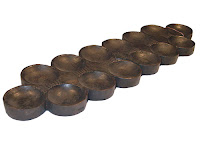 |
| An Awèlé Board Game |
Oware or awalé with many names as for example: ayo, awale, awalete, awele, oware, wari, woli,... is played in western african countries as Senegal, Gambia, Cape Verde, Guinea, Sierra Leone, Liberia, Ivory Coast, Burkina Faso, Mali, Ghana, Togo, Benin, Nigeria and Cameroon. Also in the West Indies and in the Americas as for example: Surinam, Guyana, Grenada, Barbados, Sta. Lucia, Martinique, Dominica, Antigua and St Kitts, Dominican Rep., Brazil, etc. as a result of the slave trade that came from this part of Africa.
The Rules
The aim of the game:
To capture more seeds than your opponent. At the end of the game, the player who has captured the most seeds wins.
Rules of the game:
The board is divided into two areas, hollowed with 6 holes each. At the beginning, 48 seeds are distributed among the twelve holes (4 seeds in each hole). Therefore, the players need for play a 2x6 or 2x6+2 board.


The top row belong to opponent player. You own the bottom row.
The game turn:
Every player plays alternately. The first one to play is chosen at random.
The player takes all the seeds in a hole of his/her area and distributes them counter-clockwise, one in each hole.
The player takes all the seeds in a hole of his/her area and distributes them counter-clockwise, one in each hole.
Capture:
If the last seed to be distributed falls into one of the opponent's holes, containing already 1 or 2 seeds, the player captures the 2 or 3 seeds.
The hole is left empty. The captured seeds are taken off the board or collected into the player's loft (if the players play with a 2x6+2 board).
Therefore, the hole can be captured only if, after distributing the seeds, it contains two or three seeds.
The hole is left empty. The captured seeds are taken off the board or collected into the player's loft (if the players play with a 2x6+2 board).
Therefore, the hole can be captured only if, after distributing the seeds, it contains two or three seeds.
Multiple capture:
If a player captures 2 or 3 seeds, and the preceding hole also contains two or three seeds, they are captured too, and so on.
Capturing is only allowed in the opponent's area.
Capturing is only allowed in the opponent's area.
Loop:
If the number of seeds taken in the starting hole is greater than 11, it constitutes a loop: the starting hole is left out every time in the distribution loop, and therefore, always left empty.
Feed the opponent:
A player is not allowed to "starve" his/her opponent: a player can't play a hole that leads to capturing all the seeds in his opponent's area. A player can be left with no seeds at all only if is impossible to feed him/her.
End of the game:
The game ends if a player has n seeds anymore in his/her area, and therefore can't play.
In this case, the other player captures all the remaining seeds.
Or the game ends if the game is "looping" (after some turns, the same board configuration is obtained again).
In this case, the other player captures all the remaining seeds.
Or the game ends if the game is "looping" (after some turns, the same board configuration is obtained again).
More information on the game is given by http://www.awale.info/?lang=en
Contributions with thanks from:


.jpg)


